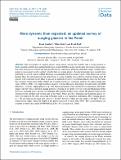Files in this item
More dynamic than expected : an updated survey of surging glaciers in the Pamir
Item metadata
| dc.contributor.author | Goerlich, F. | |
| dc.contributor.author | Bolch, T. | |
| dc.contributor.author | Paul, F. | |
| dc.date.accessioned | 2020-12-14T10:30:07Z | |
| dc.date.available | 2020-12-14T10:30:07Z | |
| dc.date.issued | 2020-12-03 | |
| dc.identifier | 271613618 | |
| dc.identifier | 1e782cb5-114b-411b-ba9a-0c075ff9b307 | |
| dc.identifier | 000596836900003 | |
| dc.identifier | 85097401266 | |
| dc.identifier.citation | Goerlich , F , Bolch , T & Paul , F 2020 , ' More dynamic than expected : an updated survey of surging glaciers in the Pamir ' , Earth System Science Data , vol. 12 , no. 4 , pp. 3161-3176 . https://doi.org/10.5194/essd-12-3161-2020 | en |
| dc.identifier.issn | 1866-3508 | |
| dc.identifier.other | Bibtex: essd-12-3161-2020 | |
| dc.identifier.other | ORCID: /0000-0002-8201-5059/work/85168584 | |
| dc.identifier.uri | https://hdl.handle.net/10023/21141 | |
| dc.description | This research has been supported by ESA (grant nos. 4000109873/14/I-NB and 4000127593/19/I-NB) and the Chinese Academy of Sciences (grant no. XDA20100300). | en |
| dc.description.abstract | The investigation of surging glaciers using remote sensing has recently seen a strong increase as freely available satellite data and digital elevation models (DEMs) can provide detailed information about surges that often take place in remote and inaccessible regions. Apart from analysing individual surges, satellite information is increasingly used to collect valuable data on surging glaciers. Related inventories have recently been published for several regions in High Mountain Asia including the Karakoram or parts of the Pamir and western Kunlun Shan, but information for the entire Pamir is solely available from a historic database listing about 80 glaciers with confirmed surges. Here we present an updated inventory of confirmed glacier surges for the Pamir that considers results from earlier studies and is largely based on a systematic analysis of Landsat image time series (1988 to 2018), very high-resolution imagery (Corona, Hexagon, Bing Maps, Google Earth) and DEM differences. Actively surging glaciers (e.g. with advancing termini) were identified from animations and flicker images and the typical elevation change patterns (lowering in an upper reservoir zone and thickening further down in a receiving zone). In total, we identified 206 spatially distinct surges within 186 glacier bodies mostly clustered in the northern and western part of the Pamir. Where possible, minimum and maximum glacier extents were digitised, but often interacting tributaries made a clear separation challenging. Most surging glaciers (n=70) are found in the larger size classes (>10 km2), but two of them are very small (<0.5 km2). We also found several surges where the length of the glacier increased by more than 100 %. The created datasets are available at: https://doi.org/10.1594/PANGAEA.914150 (Goerlich et al., 2020). | |
| dc.format.extent | 16 | |
| dc.format.extent | 16842382 | |
| dc.language.iso | eng | |
| dc.relation.ispartof | Earth System Science Data | en |
| dc.subject | G Geography (General) | en |
| dc.subject | DAS | en |
| dc.subject.lcc | G1 | en |
| dc.title | More dynamic than expected : an updated survey of surging glaciers in the Pamir | en |
| dc.type | Journal article | en |
| dc.contributor.institution | University of St Andrews. School of Geography & Sustainable Development | en |
| dc.contributor.institution | University of St Andrews. Bell-Edwards Geographic Data Institute | en |
| dc.contributor.institution | University of St Andrews. Environmental Change Research Group | en |
| dc.identifier.doi | 10.5194/essd-12-3161-2020 | |
| dc.description.status | Peer reviewed | en |
This item appears in the following Collection(s)
Items in the St Andrews Research Repository are protected by copyright, with all rights reserved, unless otherwise indicated.

